Mazda is one of the few remaining car companies that hasn’t slurped up the EV Kool Aid. It is upping the IC ante in the new CX-5 – which gets a bigger and much stronger optional IC engine for the new model year.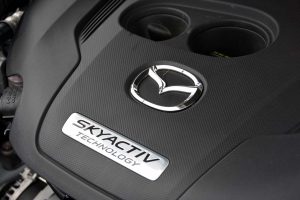
The CX-5 isn’t a muscle car, of course. But that doesn’t mean it’s not muscular.
It’s the family car that hauls a family.
What It Is
The CX-5 is Mazda’s sportier-than-most compact-sized crossover SUV.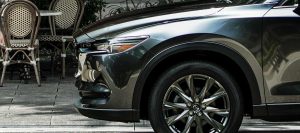
Prices start at $24,350 for the base Sport trim with a 2.5 liter engine and front-wheel-drive; all-wheel-drive can be added to the mix for $25,750.
A turbocharged version of the 2.5 liter engine is standard in GT Reserve ($34,780) and top-of-the-line Signature trims, both of which also come standard with AWD.
Whats New
To set it apart from the dozen-plus crossovers in this class, Mazda decided to offer CX-5 buyers an optional engine that’s more powerful than the engines you can get in rivals – especially rivals like the popular but underpowered Nissan Rogue.
Last year, the CX-5 came with just one engine (the 2.5 liter four, no turbo) regardless of trim.
The new, turbocharged 250 hp version of the 2.5 liter engine lops two full seconds off this crossover’s 0-60 sprint.
It also now comes standard with both AppleCarPlay and AndroidAuto.
Front seat coolers are available as well.
What’s Good
Acceleration lives up the handling – and the looks.
Uncluttered, Miata-like dashboard and controls.
Almost no MPG penalty for going with newly available 250 hp engine.
What’s Not So Good
250 hp engine only available in pricey GT and Signature trims.
You must use premium gas to get all 250 hp.
Mazda’s infotainment system controls take several steps/inputs to use.
There is a performance option now.
You can stick with the standard 2.5 liter four, which makes a class-competitive 187 horsepower (more horsepower than the Rogue’s standard 2.5 liter, 170 hp engine and its optionally available 2.0 liter hybrid engine, which makes 176 hp) or you can opt for the new turbocharged 2.5 liter engine – which makes 250 horsepower and a mighty 310 ft.lbs. of torque, too.
This is much more power than is offered in other compact crossovers, such as the Honda CR-V (190 horsepower) and Toyota RAV4 (203 hp for the updated 2020 model) and the handful of sporty compact crossovers such as the VW Tiguan (184 hp) and the just-updated Hyundai Sante Fe Sport (235 hp).
The massive horsepower and torque infusion transforms the CX-5 from a good-looking, good-handling crossover to one that also goes good. With the 2.5 liter turbo, it can get to 60 in just over six seconds vs more than eight with the 2.5 liter no-turbo engine.
And that makes it the speediest crossover in its class – with virtually no fuel-efficiency penalty, either. The CX-5 turbo gets 22 city, 27 highway vs. 24 city, 30 highway for the same CX-5 with the 2.5 liter engine.
Two of them, actually. Possibly, three -depending on your view of it.
The first is that to get the full 250 horsepower, you must use high-octane premium unleaded gas; if the engine’s ECU – the electronic brain which controls the engine – detects the cheap stuff, it will dial back the boost and the horsepower, which dips to 227.
That’s still more horsepower, though, than you get in other crossovers – with the exception of the Sante Fe, which isn’t any quicker regardless. And the 227 hp Mazda still easily outruns all the others.
But, you have to buy AWD – it’s a mandatory pairing. The standard 2.5 liter engine is available with – or without AWD. Which means, without the additional cost of AWD, if you don’t need it and prefer to save some money by skipping it.
The third catch is that Mazda doesn’t offer the hunky new engine in anything except the much-more-expensive GT Reserve and top-of-the-line signature trims. It is a mighty $9,030 bump up from the AWD-equipped Sport trim with the 2.5 liter no-turbo engine to the GT Reserve with the turbo 2.5 engine and AWD.
To be fair, you get more than just horsepower and a quicker ride to 60 by going with the GT Reserve and Signature versions of the CX-5. Both are fitted with a bevy of additional amenities and features (details follow) in addition to the amped-up engine.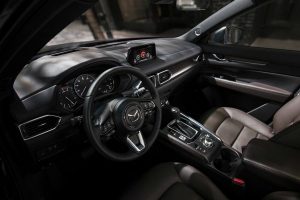
However, the fact remains that unlike the idea behind the original 1964 GTO – the first muscle car – higher performance now comes with a much higher cost. Usually, this is due to CAFE compliance pressure; higher-powered engines usually use much more gas and so there is a perverse incentive to sell fewer of them – in order to up the CAFE “fleet average” that is the basis for determining compliance with the fatwas. The higher-powered engine is available – to tout the available higher-performance and so sex up the general run.
The idea being more or less the same as having a Corvette in your lineup so as to sell more Malibus.
But in this case, Mazda seems to be doing the old-fashioned thing of dangling the extra power in front of buyer’s eyes to get them to part with more dollars. Which is fine – capitalism and all.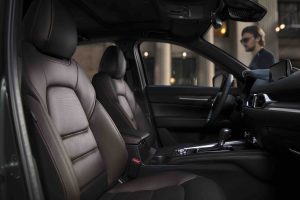
But it’s a shame that Mazda isn’t offering the 250 hp engine as a stand-alone option for the more affordable Sport, Touring and Grand Touring trims – because it runs counter to Mazda’s tradition of offering really fun-to-drive vehicles at really affordable prices.
Oddly, the CX-5’s max tow rating remans the same: 2,000 lbs – even with the much more powerful 2.5 liter turbo engine.
The CX-5, like all Mazdas, is meant for more than meatsacking. This design emphasis is evident as soon as you close the driver’s door and look in front of you. Gauges – not displays – and they are focused on the engine, not other things.
There is also a six-speed automatic rather than an automatic with eight, nine or ten speeds – the top two or three of those speeds (gears, actually) being overdrive gears designed to cut engine revs as low as possible as soon as possible, for the sake of miles-per-gallon and CAFE fatwa compliance.
Which they do, but not without cost.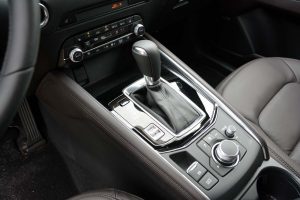
The eight-nine-and-ten-speed automatics tend to upshift too soon – and downshift too late. Think about jumping up (or down) a flight of ten stairs as opposed to six.
The CX-5’s automatic is also not a continuously variable (CVT) automatic, another gas-mileage-uber-alles type of automatic. CVTs have infinitely variable ratios rather than gears – which is great for gas mileage because the engine can be kept running at just the right spot in its powerband for given road conditions and loads. But, when you floor a CVT-equipped vehicle, the transmission will let the engine spin to very high RPM and hold it there as long as you hold your foot down. This increases drivetrain noise and makes the drivetrain seem like it’s really working hard, too.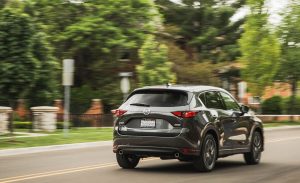
Mazda decided in favor of a traditional six-speed automatic, which doesn’t need to hunt around as much for the right gear – and which doesn’t keep the engine screaming at 5,000-plus RPM when you floor it.
The new engine completes the package, which was always among the most fun-to-drive crossovers in this class – by making it one of the quickest crossovers you can buy, period. To get quicker, you’ll have to move up a price range into BMW X3 territory – and in comparison, the turbo’d Mazda is a bargain. (The otherwise similar 2020 X3 starts at $41,400.)
Nothing but praise for how the XC-5 drives – and handles. And steers. It doesn’t have that electric-novocaine-esque sensation; your hands feel connected to the road. There is weight; just enough drag to allow precise corrections without going too far (or not far enough).
Think of it as a jacked-up Miata with seats for five and you’ll be on the right track. 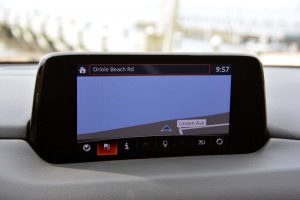
Its weak point is how you change/adjust radio stations. This is done either by rotating and pushing the knob controller mounted on the center console or by tapping the touchscreen itself. If you use the knob, it take two inputs to do one thing. For example, to go up to the next station on the dial, you first have to rotate the knob to the >> or << position and then you push the controller to go up or down. To do something else, you have to select the function, then push – and so on.
You can skip the knob and access the various functions – radio/station, GPS, apps – directly, by touching the appropriate icon on the screen. The problem there is the screen is relatively small (remember, Mazda thinks you should by paying attention to your driving, not what’s on the boob toob) and so are the icons, which are arranged on the lower part of the screen.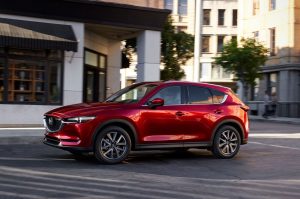
Tapping while moving isn’t easy – or rather, isn’t easily done without concentrating on the screen.
The good news is there are better things to do. Like enjoy driving this thing!
Others have to depend on the apps and various “infotainment” stuff because the drive is as far from being entertaining as marriage therapy is from a honeymoon.
Looks are another CX-5 strong suit. This model shares the good looks of other Mazdas, such as the Mazda3 and Mazda6 sedans, both of which are standouts in their classes.
Similar long-nose treatment, a styling effect as pleasing to the eye on a Jaguar E-Type or Ferrari Daytona as here.
Well, almost as.
This is, after all, a practical vehicle.
The CX-5 hasn’t got quite as much total cargo capacity as rivals like the Nissan Rogue – which has 70 cubic feet vs. 59.6 for the Mazda.
However, the CX-5’s almost 60 cubic feet is pretty close – and more to the point, isn’t small. A same-footprint compact sedan will generally have about 13 cubic feet of trunk space. Any crossover that’s about the same overall length will have at least four times as much space, plus the superior access to the space.
Another area where the CX-5 is also pretty practical is ground clearance. It comes standard with 7.5 inches, whether you go FWD or AWD. This is a bit less than the class-highest clearance Subaru Crosstrek has and less than the just-redesigned 2020 CR-V has but both of them are more focused on snow-day driving than everyday (and fast-paced) driving. And 7.5 inches of clearance is enough clearance for all but the worst snow-day driving and ample for occasionally forays onto the grass and such.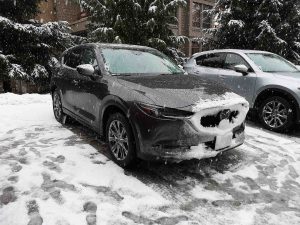
Legroom in both CX-5 rows is generous – with the backseats especially so. The Mazda’s 39.6 inches of legroom in the rear is about an inch more than in the Rogue (37.9 inches) though a little less than in the class-best Hyundai Sante Fe (40.9 inches).
The Rest
Mazda offers many driver “assists” – such as Lane Keep Assist and automated emergency braking – but they are not forced on you. Also the creepy Traffic Sign Assist – precursor to Intelligent Speed Assist (which isn’t here, yet).
You can buy these “assist” if you want to, but skip them if you want to. This is another example of Mazda bucking the trends – in a salutary way.
There is nothing necessarily wrong with all these driver “assists” – if you want them. But there are still people who don’t feel the need to be “assisted” – nudged, countermanded, beeped and chirped at – who take the role of driving seriously.
Mazda still builds cars for such people.
Another thing that may make you smile is the absence of ASS – automated stop/start. The Mazda’s engine only shuts off when you shut it off. It doesn’t cycle on and off at every red light and pause in traffic. Instead, the 2.5 turbo engine has cylinder deactivation (during low-load driving) which you’ll never notice… as opposed to ASS, which is impossible not to notice.
A heads-up display (HUD), 10-speaker Bose stereo and heated rear seats are available – but only as part of a bundled GT Premium package that you can’t get unless you first buy the GT.
All trims come standard with multiple USB power points, front and rear.
The Bottom Line
Making a sports car fun is easy; making a practical crossover genuinely sporty isn’t.
Mazda just did it.
. . .
Got a question about cars – or anything else? Click on the “ask Eric” link and send ’em in!
If you like what you’ve found here please consider supporting EPautos.
We depend on you to keep the wheels turning!
Our donate button is here.
If you prefer not to use PayPal, our mailing address is:
EPautos
721 Hummingbird Lane SE
Copper Hill, VA 24079
PS: Get an EPautos magnet (pictured below) in return for a $20 or more one-time donation or a $10 or more monthly recurring donation. (Please be sure to tell us you want a sticker – and also, provide an address, so we know where to mail the thing!)
My latest eBook is also available for your favorite price – free! Click here. 


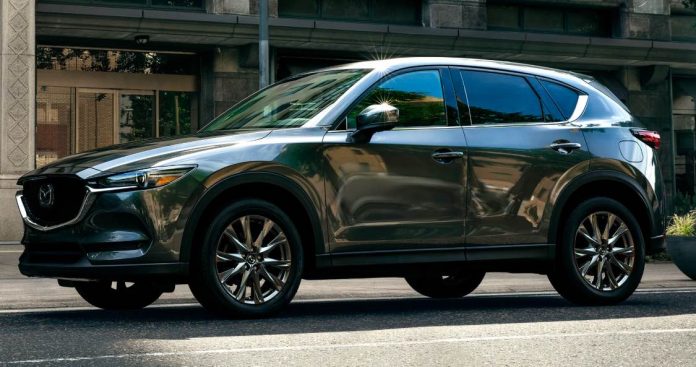

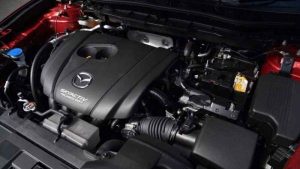
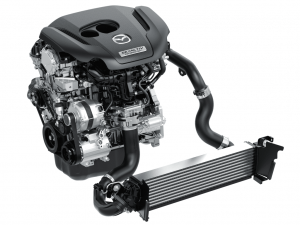
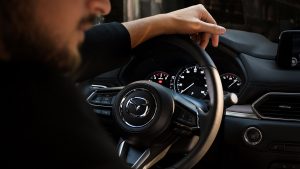

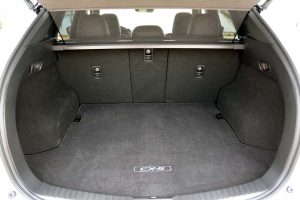








Hi Bill,
I think GM has already done so.
Jeremy
Looks like a decent car for those who don’t like the crap that the other manufucturers are making- bnut…
I don’t suppose it’s available with a stick?
And the idea that you have to buy all these packages/trim-level upgrades to get certain options, would be a deal killer.
Why the F can’t they just offer options individually for those who want them? And does everyone really want AppleP;layu or Android-whatever, that they have to make it standard? I certainly wouldn’t want any of that- nor a touchscreen….sol it being “standard” is really just making me pay more for something I’d never use.
Mazda is on the right track though…. I could see someone like me buying this for $25K (not that I would buy a new car!) if ya could get it with a stick for that price- or even less- but sheesh! when it starts getting up into the mid 30’s- $40K after all the little details, additional fees and taxes…..uh…no.
At last, Mazda touches all the bases.
1. Class leading power. New territory for this maker.
2. NO CVT.
3. Good looks, handling and practicality; areas where they usually have done quite well.
Not sure if I were in this segment that the CX-5 is the one I’d buy. Have to personally decide just how bad the sound system, and other digital interfaces are….or are not. Also, I still doubt that Mazdas have as high a quality/reliability/durability factor as Hondas and Toyotas.
But the new RAV-4 is just too ugly. So for me, it would come down to the CRV or the Mazda. I do like having the most power possible. Odds are 50/50.
God help this country when everything less than a pickup truck comes with the cursed CVT. It’s almost to that point. Thank God Mazda hasn’t yet. Looking at the power train offerings and body style, Mazda still has a tinge of masculinity compared to Hyundai.
I love what mazda has been up to. I really like their designs so much better than the indistinct and bland competitors.
Maybe the CX-5 will be the start of something BIG – nudging other compact crossover SUV manufactures
to offer vehicles with some high-performance capability. Currently, too many are too close to being mere appliances.
Hi Liberty,
I sing the praises of companies like Mazda and FCA at every opportunity because they have not given in – yet. They play along, to the degree they must. But, notice – no unctuous amen’ing of the orthodoxies. You hear the sound of one hand clapping.
Since Ford has switched to mostly SUVs, and they have the 2.7L twin-turbo V6, I’m hoping for some positive performance results via a Ford compact SUV.
Hi libertyx,
I should be getting the 2020 Escape in a few weeks; we’ll see!
It will be interesting to see which manufacturer is the first to un-person you.
Hi Bill,
GM already did. I used to be on very good terms with them, before it all went to shit – before GM became the New GM, post bailout and became a “diversity” (i.e., anything but-white-straight-male) company rather than a car company.
I remember maybe the last 2 cars GM sent to you. One was the retro-Camaro, and the other was the Cruze Diesel with the piss-tank in the trunk! You can’t hardly see out of the Camaro, let alone rest an arm on the widow-sill, and I don’t even want to discuss the other one. I guess when a company can’t take criticism, it just shoots the critic, now.
I have to say, you ALWAYS have great things to say about any brand, and you have written paragraphs of positive attributes, when I couldn’t find enough to write one sentence without gagging, lol!
Thanks, Graves!
I may not personally like a given car or a given company, but I try very hard to review every car according to objective criteria and from the point of view of someone who is in the market for a car of that type. Whether I personally like it is an irrelevance – though I will say so, if I do!
In re GM: The sad thing is, I’m one of the very few remaining car journalists who isn’t hostile toward the industry; who tries to defend it against the galloping idiocy which is going to destroy it if not stopped. But Ms. Barra, et al are more interested in “diversity” peddling than whether GM exists ten years from now.